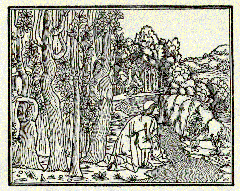Introduction
Typography
- Fonts
- Text and image
- Technopaegnia
Woodcuts
Cinematic visual logic
- Moving bodies
- Double page spread
- Filmic sequences
Architecture
Gardens and landscapes
Other editions
Mysterious messages
Eros and metaphor
Technical innovations
External links
Woodcuts
The 172 woodcuts are at least as studied as the font of the Hypnerotomachia. The book is unique in being the only illustrated one to have been published by Aldus. Yet the identity of the cutter is unknown. Most of the woodcuts from this period are mediocre. This is no doubt because, as we know from Arthur Hind, in the late fifteenth century, book woodcuts were still considered an inferior art form, especially compared to illuminations, but indeed among the visual arts in general. …The Hypnerotomachia is one of the two Venetian books that does stand out for its great quality; the other is the Malermi Bible, named after its Italian translator, which was printed in 1490 and reprinted in 1493 by Giovanni Ragazzo for Lucantonio Giunta with 373 woodcuts. The images of the Hypnerotomachia are far superior. They are distinguished by their design in the same ‘stil nuovo’ as the high arts of the time. Sculpted by a woodcutter, their original designs have been associated above all with Andrea Mantegna who, more than any other figure, shaped the new classicizing style in engraving. However, they also have been associated with the work of Fra Giocondo, Vittore Carpaccio, and Gentile Bellini. Scholars have even been tempted to see the influence of the young Raphael, an attribution that is difficult to support as Raphael was sixteen years old at the time.

Poliphilo hears the music
(from pp. 14, 18 of L. Lefaivre’s
Leon Battista Alberti’s
Hypnerotomachia Poliphili).
Copyright © 1997. The MIT Press. All rights reserved.